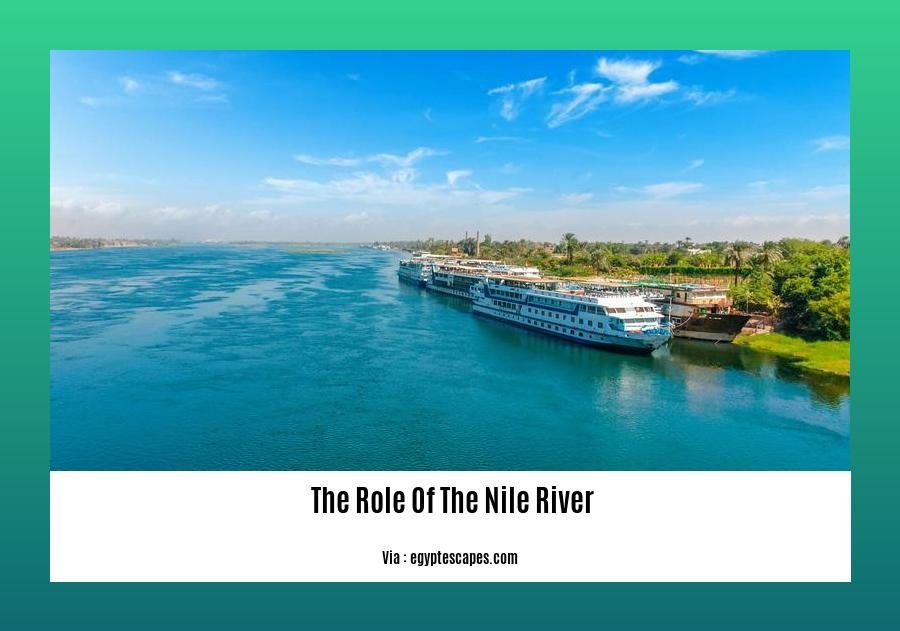– The Role of the Nile River in the Rise and Flourishing of Ancient Egypt –
The Nile River, the lifeblood of ancient Egypt, played a pivotal role in the rise and flourishing of one of the world’s most remarkable civilizations.
Key Takeaways:
- The Nile River provided fertile soil and water for irrigation, enabling ancient Egyptians to cultivate their crops.
- Cities could be established in the desert because of the Nile’s life-giving properties.
- The river transformed arid lands into prosperous agricultural areas.
- The Nile was a critical transportation and trade route, connecting Egypt to other civilizations.
- Annual flooding replenished farmland, ensuring a reliable food supply.
- Settlements have existed along the Nile River’s banks since before the advent of written history.
The role of the Nile River

The Nile River, a lifeline coursing through the heart of ancient Egypt, played a pivotal role in the rise and prosperity of this extraordinary civilization.
The Nile’s fertile banks and reliable waters provided the nourishment for agriculture, the foundation of the Egyptian economy. The annual flooding enriched the soil, transforming the arid surroundings into a verdant cornucopia. This dependable source of sustenance allowed the population to flourish, giving rise to bustling cities and monumental structures.
The Nile as a Life-Giving Artery
The Nile River served as a vital transportation and trade route, connecting Egypt to the outside world. Its navigable waters facilitated the transport of goods, ideas, and people, fostering cultural exchange and economic growth. Egyptians used the river to transport massive blocks of stone for constructing pyramids and temples, illustrating the Nile’s indispensable role in shaping the architectural wonders of ancient Egypt.
The River’s Rhythmic Cycle
The Nile’s predictable annual flood cycle was both a blessing and a challenge. While flooding replenished farmlands, it also necessitated the development of complex irrigation systems to regulate the water flow. The Egyptians mastered these techniques, ensuring a reliable water supply for their crops and settlements.
Settlements and Spirituality
The Nile River attracted settlements along its banks since before written history. Its bountiful resources and strategic location made it an ideal place to establish villages, towns, and eventually the grand cities of ancient Egypt. The river also held religious significance, with the Egyptians believing it to be a manifestation of the god Hapi.
Conclusion
The role of the Nile River in ancient Egypt was multifaceted and profound. Its waters provided sustenance, transportation, and spiritual connection, shaping the very fabric of Egyptian society and culture. The Nile River remains an enduring symbol of the interconnectedness between geography, civilization, and human ingenuity.
Explore the rich tapestry of the History of Egypt, from its ancient roots to its bustling present. Delve into the enigmatic world of the Ancient Egyptian civilization, with its iconic pyramids and hieroglyphic scripts. And witness the transformative modern Egypt’s development, as the country strides boldly into the future.
Nile River as a Facilitator of Agriculture
The Nile River as a Facilitator of Agriculture had a critical role in fostering the agricultural prowess of ancient Egypt. Flowing through the arid lands of North Africa, the Nile provided the indispensable resource of freshwater to support irrigation practices.
Imagine a fertile oasis of green sprawling along the banks of the mighty river. Like life-giving veins, irrigation systems diverted water from the Nile to far-reaching fields, transforming arid soil into lush farmland. This nurturing water source sustained an array of crops that formed the backbone of Egyptian society. From wheat and barley for bread to fruits and vegetables, this agricultural bounty fueled the growth of a thriving population and laid the foundation for the rise of civilization along the Nile’s banks.
Key Takeaways:
- The Nile’s annual floods left behind nutrient-rich sediment, enhancing soil fertility and bolstering crop yields.
- Irrigation systems, powered by the Nile’s water, allowed farmers to cultivate crops throughout the year, ensuring a reliable food supply.
- The abundance of agricultural produce supported a diverse and growing population, fostering economic prosperity and societal advancements.
Sources:
- The Nile River Basin: Water, Agriculture, Governance and Livelihoods
- The Nile River Basin Water, Agriculture, Governance and Livelihoods
Nile River as a Source of Building Materials

The **Nile River** provided a wealth of building materials for the ancient Egyptians. The fertile banks of the Nile were abundant in clay, which was used to make bricks for construction. The Egyptians also quarried limestone and sandstone from the cliffs along the river's banks. These stones were used to build temples, pyramids, and other monumental structures.
### **Methods of Quarrying**
The Egyptians used various methods to quarry stone from the Nile River cliffs. One common method was to use a chisel and mallet to chip away at the rock. They also used levers and wedges to pry loose large blocks of stone. Once the blocks were quarried, they were transported to the construction site by boat or sled.
### **Uses of Stone in Construction**
The Egyptians used stone in a variety of ways in their constructions. Limestone and sandstone were the most commonly used stones. Limestone was used to build the pyramids and other large structures. Sandstone was used to build temples and other smaller structures. Granite was used to make statues and other decorative elements. Travertine was a type of limestone that was used to make tiles and flooring.
### **The Importance of the Nile River**
The Nile River was essential to the development of ancient Egyptian civilization. The river provided a reliable source of water for irrigation, transportation, and building materials. Without the Nile River, the ancient Egyptians would not have been able to build their great civilization.
Key Takeaways:
- The Nile River provided an abundance of building materials for the ancient Egyptians.
- The Egyptians used various methods to quarry stone from the Nile River cliffs.
- Limestone, sandstone, granite, and travertine were the most commonly used stones in Egyptian construction.
- The Nile River was essential to the development of ancient Egyptian civilization.
Relevant URL Sources:
– The Nile River: A Source of Building Materials for Ancient Egypt
– Ancient Egypt: Architecture and Building Materials
Nile River as a Symbol of Divine Power
The Nile River was more than just a lifeline for the ancient Egyptians; it was a symbol of something divine and sacred. Here’s how the Nile’s divine aura shaped the beliefs and practices of this ancient civilization:
Hallowed Waters
The Nile’s annual flooding brought life-giving water to the parched lands of Egypt. As the waters receded, they left behind rich soil ideal for agriculture. Egyptians believed that this life-giving aspect of the river was a manifestation of divine power.
Abode of Deities
The Nile was considered the home of several deities, including Hapi, the god of the annual flood, and Nun, the primordial waters from which all life originated. The Egyptians believed that the Nile’s waters had transformative powers, purifying and rejuvenating those who immersed themselves in it.
A Sacred Boundary
The Nile marked the border between the fertile black lands of Egypt and the barren desert surrounding it. This division created a sense of sacred space within the Nile Valley, a place where the divine presence was believed to be stronger. Temples and religious rituals along the river’s banks reinforced the Nile’s divine significance.
Celestial Symbolism
The Nile’s course mirrored the Milky Way in the night sky. Egyptians believed that the Milky Way was the heavenly counterpart of the Nile, a celestial river of stars. This association further enhanced the Nile’s divine status, connecting it to the eternal realm.
Conclusion
The Nile River as a Symbol of Divine Power was an integral aspect of ancient Egyptian religion and culture. Its life-giving waters, divine inhabitants, and celestial connections imbued the Nile with an aura of sanctity, shaping the beliefs and practices of a civilization that flourished along its banks for centuries.
Key Takeaways:
- The Nile River was a symbol of divine power due to its life-giving waters.
- The Nile was believed to be the abode of deities such as Hapi and Nun.
- The Nile marked the boundary between sacred and profane space.
- The Nile’s course mirrored the Milky Way, symbolizing its celestial significance.
Relevant URL Sources:
– The Myth of the Nile: The Sacred River and Its Role in Ancient Egyptian Religion
– Nile River and Ancient Egypt Religion: The Evolution of a Complex Religious System
FAQ
Q1: How did the Nile River contribute to the agricultural success of Ancient Egypt?
A1: The Nile River provided fertile soil and a reliable source of water for irrigation, enabling the Egyptians to cultivate crops and establish a thriving agricultural society.
Q2: What role did the Nile River play in the development of trade and commerce in Ancient Egypt?
A2: The Nile River served as a vital transportation route, facilitating the movement of goods and materials within Egypt and beyond its borders, fostering trade and economic prosperity.
Q3: How did the Nile River influence the religious beliefs and practices of the Ancient Egyptians?
A3: The Nile River was considered a sacred and life-giving force by the Ancient Egyptians, who associated it with various gods and goddesses. They held festivals and rituals honoring the river and incorporated its symbolism into their religious beliefs and practices.
Q4: What was the significance of the Nile River in the construction of monumental structures in Ancient Egypt, such as the pyramids?
A4: The Nile River provided a convenient and efficient means of transporting heavy materials, such as stone blocks, to construction sites. It also served as a source of water and sustenance for the workers involved in these massive building projects.
Q5: How did the Nile River impact the political and social organization of Ancient Egypt?
A5: The Nile River played a crucial role in shaping the political and social landscape of Ancient Egypt. It facilitated the formation of centralized states along its banks, led to the development of a hierarchical social structure, and influenced the distribution of wealth and power within Egyptian society.
- China II Review: Delicious Food & Speedy Service - April 17, 2025
- Understand Virginia’s Flag: History & Debate - April 17, 2025
- Explore Long Island’s Map: Unique Regions & Insights - April 17, 2025
















